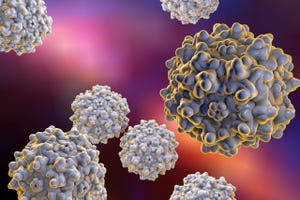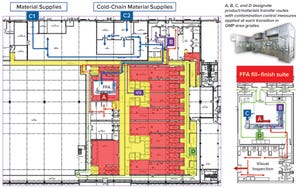October 2021 Featured Report
Adenoassociated virus (AAV) is ideal for gene therapy delivery because it is nonpathogenic, exhibits low immunogenicity, and readily enters several cell types.
https://www.stock.adobe.com
Given the potentially curative nature of gene and gene-modified cell therapies and the successful launches of several such products over the past five years, markets and investments are growing significantly in the sector. In the United States alone, the US Food and Drug Administration has granted approval for several genetic therapies, including
Investments in gene therapy companies increased by 70% in 2020 (
1
), and at the beginning of 2021, 423 clinical trials were underway for candidate gene therapies, with roughly half of those in phase 2 studies. That includes candidate treatments for eye diseases, infection by human immunodeficiency virus (HIV), sickle cell disease, cystic fibrosis, congestive heart failure, hemophilia, cancer, and several other genetic disorders (
2
).
Nearly 70% of approved and pipeline gene t...
As anyone who has focused on host-cell proteins as process contaminants can tell you, trying to purify a specific type of molecule from a large mixture of many similar molecules is like trying to find a few particular needles in a huge pile of varied needles. The same could be said for purifying viral vectors from cell culture fluids. When viruses are the products, unwanted viruses are contaminants that must be separated away — or better yet, prevented from being there in the first place.
Viral safety is a critical aspect of downstream processing for biologics, especially those derived from mammalian cell lines. And it’s not only about protecting patients from infection; it’s also about protecting the drugs from unwanted immune responses. Such responses dampened early hopes for adenoviruses as gene-therapy vectors — some serotypes are so common in the environment that many patients are already primed and readied to respond to their presence with an attack. To make things worse, some people’s bodies can ov...
Over the past few years, Oxford Biomedica Ltd. (OXB) has developed and implemented a fill–finish platform (“Oxbox,” Figure 1) at its viral vector processing facility in the United Kingdom. The facility includes four segregated bulk viral-vector drug substance (VS) suites, where closed systems and bioburden control processes apply, and two viral-vector drug product (VP) fill–finish suites that apply aseptic processing, with space for expansion by scale-out as product output demand increases. Segregated suites enable the facility to process different viral vectors simultaneously, including OXB’s own LentiVector delivery platform and other types of viral vectors, by acting as a contract development and manufacturing organization (CDMO) through strategic partnerships.
Figure 1: Oxbox viral vector facility at Oxford Biomedica UK
The Oxbox processing platform combines a VS pooling stage that applies bioburden control with a VP concentration process that incorporates single-use closed systems followed by automat...
A ribbon diagram representing the capsid of adenoassociated virus serotype 2 (AAV2, one fivefold-symmetry axis shown at center)
https://www.wikipedia.org
Gene therapies based on adenoassociated virus (AAV) vectors hold promise for treating myriad conditions. Immunogenicity remains a challenge for such products, however. With support from PerkinElmer, Roland W. Herzog (professor of pediatrics and Riley Children’s Foundation professor of immunology at the Indiana University School of Medicine) joined Nagendra Venkata Chemuturi (scientific director of global research for drug metabolism and pharmacokinetics, DMPK, at Takeda Pharmaceuticals) to deliver a BPI “Ask the Expert” presentation exploring strategies for minimizing immune responses to AAV-based products. Herzog described emerging research on the role of innate immune signaling in adaptive immune responses to AAV. Chemuturi highlighted the increasing importance of clinical pharmacological tools for evaluating AAV biodistribution.
Herzog’s Presentation
Subscribe to receive our monthly print or digital publication
Join our 70,000+ readers. And yes, it's completely free.








